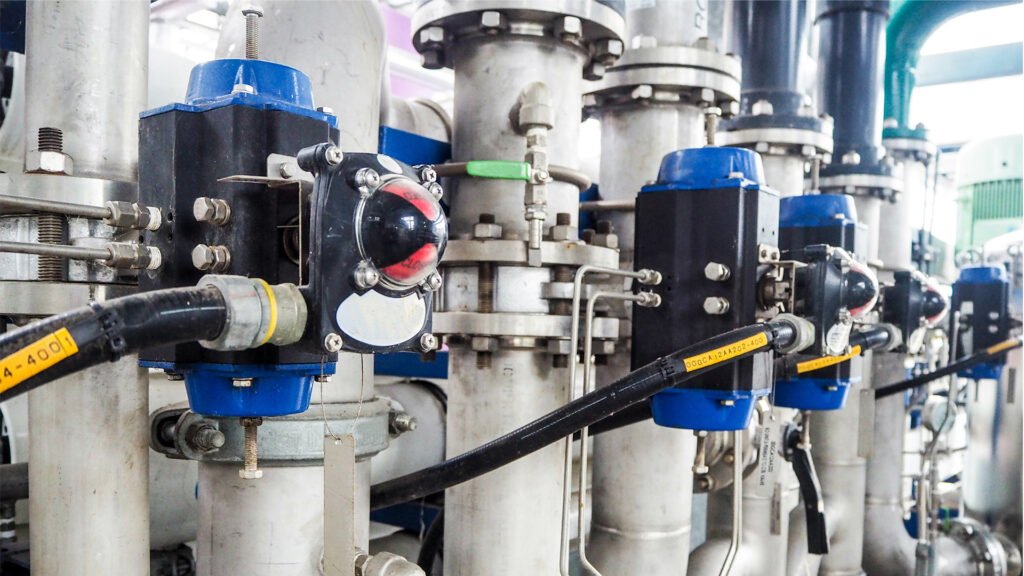Introduction
Pneumatic control valves are critical components in industrial automation, ensuring the precise regulation of air and gas flow. However, even high-quality valves can experience performance issues over time. Understanding common problems and their solutions can help prevent downtime, improve efficiency, and extend the life of your pneumatic system. This guide will cover the most frequent pneumatic control valve issues, troubleshooting techniques, and the latest trends in predictive maintenance.
Common Issues and Troubleshooting Solutions:
- Air Leaks
Symptoms
- Hissing sounds near valve connections
- Drop in system pressure
- Inconsistent valve operation
Causes
- Worn-out seals or gaskets
- Loose fittings and connections
- Cracks in the valve body
Solutions
- Inspect seals and replace damaged ones.
- Tighten fittings and ensure proper pipe alignment.
- Use leak detection sprays or ultrasonic leak detectors to pinpoint hidden leaks.
- Valve Sticking or Slow Response:
Symptoms
- Delayed or sluggish valve actuation
- Inconsistent airflow regulation
- Partial or incomplete opening/closing
Causes
- Contaminants such as dust, dirt, or oil buildup
- Insufficient lubrication
- Worn-out actuator components
Solutions
- Clean the valve and internal components using manufacturer-approved cleaning agents.
- Apply the correct type of lubrication to moving parts.
- Check actuator settings and replace worn-out parts if necessary.
- Erratic or Unstable Valve Operation:
Symptoms
- Fluctuating air pressure
- Irregular valve cycling
- Unexpected shutdowns
Causes
- Incorrect pressure settings
- Blocked or clogged air lines
- Faulty solenoid or pilot valve
Solutions
- Verify system pressure and adjust to recommended levels.
- Clean air filters and ensure unobstructed air supply lines.
- Test solenoids and electrical connections; replace faulty components.
- Excessive Noise or Vibrations:
Symptoms:
- Unusual rattling or high-pitched noises
- Increased system vibrations
- Pressure fluctuations during operation
Causes
- Loose mounting brackets or improper installation
- Air turbulence due to incorrect valve sizing
- Worn-out internal components
Solutions
- Secure the valve with proper mounting and isolation techniques.
- Ensure the valve size matches the system’s flow requirements.
- Inspect internal components for wear and replace if necessary.
- Overheating of Solenoid Coils:
Symptoms
- Excessively hot solenoid coils
- Intermittent electrical failures
- Burnt coil smell or discoloration
Causes
- Overvoltage or power surges
- Continuous duty operation beyond rated capacity
- Poor ventilation around the valve
Solutions
- Verify voltage ratings and ensure compatibility with the power supply.
- Use coils rated for continuous operation if necessary.
- Improve cooling and ventilation around the valve assembly.

Latest Trends in Pneumatic Valve Troubleshooting:
- IoT-Enabled Predictive Maintenance
- Sensors integrated with pneumatic valves detect pressure fluctuations and performance anomalies.
- Real-time monitoring helps prevent failures before they occur.
- AI-Based Diagnostics
- Machine learning algorithms analyze valve performance data to identify failure patterns.
- Automated troubleshooting guides assist maintenance teams with step-by-step solutions.
- Energy-Efficient Valve Designs
- Newer pneumatic valves consume less air and reduce wear, leading to fewer maintenance issues.
- Improved seal materials enhance durability and minimize leaks.
- Modular Valve Systems
- Easily replaceable modular components reduce downtime and troubleshooting complexity.
- Quick-connect fittings enable faster maintenance and system modifications.
Conclusion
Troubleshooting pneumatic control valve issues requires a systematic approach to diagnosing and resolving problems effectively. Regular maintenance, real-time monitoring, and leveraging modern predictive technologies can significantly improve system performance and longevity. By staying ahead of potential failures, industries can reduce downtime, optimize efficiency, and extend the life of their pneumatic systems.
For expert advice on troubleshooting and maintaining pneumatic control valves, contact our team today!
Why Choose HybridOX Automation LLP?
At HybridOX Automation LLP, we are a leading manufacturer, supplier, and exporter of premium-quality industrial control valves. Our extensive range of pneumatic control valves, actuators, and automation solutions ensures enhanced efficiency, safety, and cost savings for industries worldwide. With a focus on cutting-edge technology and industry-specific solutions, we provide customized flow control products that meet the evolving demands of oil & gas, chemical, food & beverage, and water treatment sectors. Contact us today to explore how our high-performance control valves can optimize your industrial automation needs.
